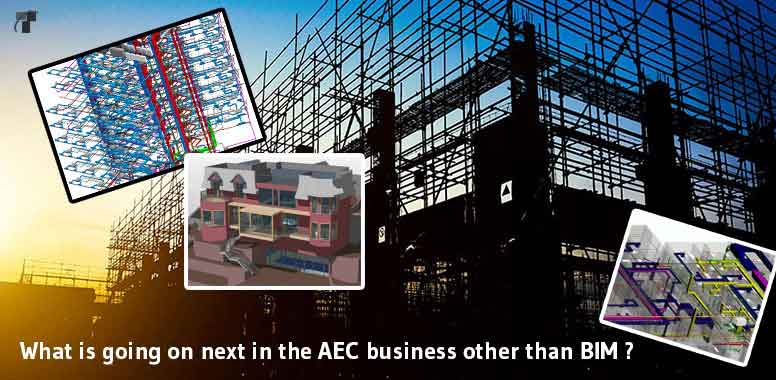What is going on next in the AEC business other than BIM?

Overview
Table of Contents
In primitive times, construction comprised Mud huts and Stonehenge. Over time, construction practices have been refined with making building more permanent structures. Urbanization and population started increasing where contemporary construction had begun. Earlier construction was very costly and involved a lot of labor. No proper tracking was done, and the resources were depleted. A constructed building could not contribute to society and impact negatively it.
But as and when times changed, mega trends influenced the way construction took place. Technology transformations brought a new era for the construction industry. The first technological breakthrough in the construction industry was the use of CAD systems followed by BIM Modeling Services. BIM technology is a relatively newer trend that was introduced in the ‘90s. BIM has brought about a sort of revolution in the industry and opened up new gateways for technological advancements. Let’s get an overview of all the growing technologies:-
Augmented Reality & Virtual Reality
Augmented reality is a technology that allows digital objects to be covered in the real world. It is one of the key innovators that will create a strong integration between the digital and physical phases of building design and construction. With the help of BIM Coordination Services, it enables to visualization of the model through the augmented environment created.
Virtual Reality provides a virtual walk through the digital model created to enhance the user experience and monitor the clashes in the model. It showcases exterior and interior surroundings that include a view of doors, windows, lightnings, textures, and the neighborhood. Before actual construction, the client could know how the building or structures would look like. Virtual Reality enables easy communications and BIM Collaboration between all disciplines.
Construction Software and Data Ecosystem
Real-time project management software is advancing the construction industry these days. With this software, it can increase sustainability soon. The data ecosystem allows everyone to share data; experience and project knowledge will come together.
The use of digital tools makes these bits of information more valuable and enhances the minimization of delays, rework rates, and communication gaps between the site and the office. Advantages to be leveraged from it are Efficiency, Transparency, and Accountability. The software provides real-time communication, project overview, trackability, and integrations with other software.
Modular Construction
Modular Construction or Pre-fabricated Construction is the development of the building structure off-site and transporting it to the desired site. No change in building materials and supplies is observed, but the job is done in less time. Renovate or modular construction is an option available out of which modular construction is a very effective and new method of construction. Quality assurance test is conducted to make the building is sanctioned under the code provided. It requires accurate data and measurements to work.
Modular construction has many benefits including material waste deductions and getting rid of weather delays as all the pre-fabrication work is conducted inside the factory. Building modulated greater flexibility allowing purposes such as relocating to a new place or re-purposing materials
Drones
Drones are an emerging technology used in the construction industry as it saves a lot of time. It provides accurate and precise readings where less human involvement becomes a necessary part. Footage captured from the Drone helps us to analyze the progress of the project. Increases speed of job done faster and in less money.
With Drones, we can get access to see the visualization of both work in progress and work remaining and give key safety assessments on it. Contractors widely use it for construction work.
Robotics
Robotics technology is often expensive and mostly not accepted by a lot of construction companies, but it is turning out to be one of the growing technologies where It can perform the work of 3D printing of materials used in on-site construction, lay bricks and tie rebar providing precise and accurate work. It helps to boost productivity and accuracy while reducing waste. The loss of skilled laborers won’t affect construction work anymore as the manual process is automated and provides contractors to deliver the projects faster and more efficiently.
Cloud Technology
Cloud Computing technology can easily get connected to mobile devices from anywhere and at any time and is going to be booming technology for the nearer future. It provides many benefits to be leveraged from such as storing a limited amount of data that can easily be shared and is less expensive too. Cloud-based platforms enable tracking the project in real-time with accurate information provided. By capturing accurate data from the cloud, mobile devices would have a positive impact on construction collaboration and productivity in 2019.
Wearable Technology
Wearable technology is going to be fruitful in the coming years, as it can change the way we operate. Equipment that will provide safety measurements for job site and increases productivity for the construction industry will be in greater demand. New Technology that you might be interested in investing in is smart glasses, smart helmets, and Exoskeleton suits.
Communication is stronger due to contractors being in constant touch with workers and work becomes more productive due to each instruction being followed and can supervise the work in progress. Any accident that takes place can be tracked.
Green Construction
Lifestyles of the consumer have now changed and become healthy due to which there is growing interest in green construction. Major industries are influenced by the ideal concept of reducing water, purchase of disposable goods, and an increase in collaborative consumption.
Green construction promotes waste reduction, the use of proper resources, giving a healthier environment for people to live in, and less damaging impact. LEED Certification is mandatory to be issued before starting any green construction to provide sustainability in construction. This is where 6D BIM comes into the picture of providing sustainability in construction to create a positive impact on society.
Big Data and Business intelligence
Data Analytics is the brightest future of the construction industry. This technology allows contractors to collect, parse and evaluate greater amounts of construction data. Data Analytics is not easy to compose; it is integrated into larger construction ERP solutions to make it easy for visualizing data. It helps to boost productivity and reduces time wasted in supervising the work progress by enabling sensors to track data easily. Provides accurate data and safety measurements to track if any incidents happen in the work environment.
Conclusion
Construction Industry has seen a fruitful transformation in the way it works since 2011. All the technologies are reshaping the construction industry and implementing these technologies can bring rewards like increased productivity, better collaboration, delivering projects on time, and earning higher profit margins. All the technologies somewhere or other positively impact the design, construction, and operation phase. It may seem to be expensive but one investment can give long-term benefits to all companies. It builds strong communication and creates a virtual stand for the user to experience the model that is going to be prepared digitally to supervise all the processes of construction.

